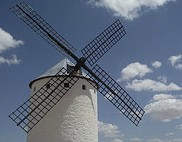
Wind Mills and Don Quixote
Southern Spain, and Andalusia especially, is known as the land of windmills. The reason for this is pretty simply. There happens to be a lot of strong, and steady wind in the region, coming off the Mediterranean and the Atlantic, blowing through the south of Spain.
The idea of windmills on the Iberian Peninsula was first romanticized and satirized by the Spanish author Miguel de Cervantes. He penned the cherished book ‘The Ingenious Gentleman Don Quixote of La Mancha,’ general referred to as ‘Don Quixote’ for simplicity. When Cervantes created Don Quixote, at the beginning of the 17th century, he put the region of La Mancha, and its many windmills, on the global literary map.
In order to better understand the story, and its relationship to windmills, we should first look at the main protagonist of this novel. The book introduces us to Alonso Quijano, an aging Spaniard living in La Mancha. This man has great notions of chivalry, and a ‘lost’ age floating through his mind. He decides to rename himself Don Quixote, recruits a ‘squire’ by the name of Sancho Panza, who is in fact a rotund but very practical farmer, and ventures out into the world to have some adventures, or at the very least some misadventures.
Don Quixote believes himself a gentlemanly knight, in a place and time when that wasn’t really practical for him. The book, which details his many forays out into the land, is now considered a classic of Western and Spanish literature. Don Quixote is a flawed character, often ridiculed by the author, but the reader comes to love him just the same. His defects and confusions are very endearing to the audience.
As for the windmills, which you can still find scattered across the region, even to this day (although of the modern variety), they are pivotal in Don Quixote’s view of himself, and of the world. During his rides with Sancho Panza, Don Quixote tilted at, or jousted with windmills because he thought they were giants. When he saw thirty or forty windmills in his path, he believed them to be ‘hulking giants.’ And so the chivalrous ‘knight’ lowered his lance and charged. He mistook the blades of the windmills for the ‘arms’ of the giants. As you can probably imagine, his titling didn’t go down as smoothly as he would have liked.
If you’ve ever heard the phrase, ‘tilting it windmills,’ which means going after something that is imaginary, and trying to defeat it, you now know the origins of that phrase. The next time you’re driving or biking through southern Spain, you’ll have a new appreciation for all of the windmills you’ll inevitably see, dotting the horizon.
 Follow
Follow


